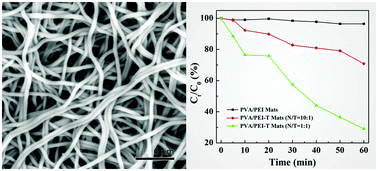Selective removal of mercury ions using thymine-grafted electrospun polymer nanofibers
Abstract
Removal of hazardous metal ions from industrial wastewater is of paramount importance. Taking advantage of the metal–ligand binding specificity and electrospun nanofibers with a high surface area to volume ratio and a porous structure, we developed thymine (T)-grafted poly(vinyl alcohol) (PVA)–polyethyleneimine (PEI) nanofibers for selective removal of mercury ions (Hg2+) with high efficiency. In this study, thymine-1-acetic acid was first grafted with the primary surface amines of branched PEI via a 1-ethyl-3-(3-dimethylaminopropyl)carbodiimide coupling reaction. The formed PEI–T conjugate was mixed with PVA solution for subsequent formation of T-grafted electrospun PVA–PEI (PVA–PEI-T) nanofibers. The formed PEI–T conjugate and the crosslinked PVA–PEI-T nanofibers were characterized via different techniques. We show that the grafting of the T moieties onto the surface of PEI does not appreciably impact the smooth fibrous morphology of PVA–PEI-T nanofibers when compared with the PVA–PEI nanofibers without T grafting, except that the T-grafted fibers have slightly increased fiber diameter. With the grafting of T moieties, the formed PVA–PEI-T nanofibers enabled selective removal of Hg2+ from aqueous solution and improved removal efficiency was able to be achieved by increase of the T-grafting density on the PEI surface. With the good reusability for repetitive Hg2+ removal, the newly developed T-functionalized PVA–PEI nanofibers may hold a great promise for high-selectivity and high-efficiency removal of Hg2+ from laboratory and industrial wastes.


 Please wait while we load your content...
Please wait while we load your content...